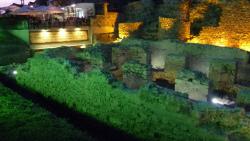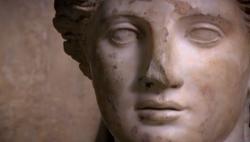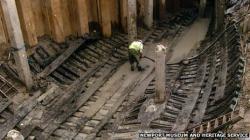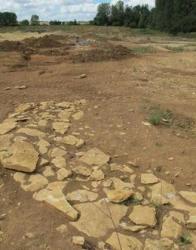INSTITUT SUPERIEUR D'ANTHROPOLOGIE
INSTITUTE OF ANTHROPOLOGY
ONLINE COURSES / COURS A DISTANCE
INSCRIPTION : Année Universitaire 2012/2013
REGISTRATION : Academic Year 2012 / 2013
BULGARIE –  Sozopol - Archaeologists have found the long sought-after oldest necropolis of ancient Apollonia, the Black Sea town that was the predecessor to today’s Sozopol in Bulgaria. The discovery was made in the area of the fortress gate and southern wall of the old town. It is a long-awaited sequel to the discovery of part of the necropolis in 1972 by Mihail Lazarov. The newly-discovered four gravesites were found two metres below the foundations of the church found by archaeologists at the start of this year’s archaeological season near the southern entrance to the stone wall in Sozopol. There is evidence that the core of the ancient necropolis may be dated to the second half of the sixth century BCE, according to a report on September 3 2012 by public broadcaster Bulgarian National Television. At the gravesites of children, amphorae were found with pottery and balm as burial gifts. According to the report, it was believed that the ceramics had been imported fromCorinthand had been made about 540 BCE. Dimitar Nedev, director of the Historical Museum in Sozopol, said that the ceramics had been very popular items, widely found on the territory of ancient Greece, but were a rare find in this area.
Sozopol - Archaeologists have found the long sought-after oldest necropolis of ancient Apollonia, the Black Sea town that was the predecessor to today’s Sozopol in Bulgaria. The discovery was made in the area of the fortress gate and southern wall of the old town. It is a long-awaited sequel to the discovery of part of the necropolis in 1972 by Mihail Lazarov. The newly-discovered four gravesites were found two metres below the foundations of the church found by archaeologists at the start of this year’s archaeological season near the southern entrance to the stone wall in Sozopol. There is evidence that the core of the ancient necropolis may be dated to the second half of the sixth century BCE, according to a report on September 3 2012 by public broadcaster Bulgarian National Television. At the gravesites of children, amphorae were found with pottery and balm as burial gifts. According to the report, it was believed that the ceramics had been imported fromCorinthand had been made about 540 BCE. Dimitar Nedev, director of the Historical Museum in Sozopol, said that the ceramics had been very popular items, widely found on the territory of ancient Greece, but were a rare find in this area.
http://sofiaglobe.com/2012/09/03/archaeology-oldest-necropolis-of-ancient-apollonia-found-in-bulgarias-sozopol/#!prettyPhoto/0/
IRLANDE – Carrowmore - Archaeologists exploring links among early medieval monasteries in Ireland, Britain and mainland Europe have discovered important evidence of a settlement in Co Donegal. The team of tutors and students from the University of Sunderland made their discovery last week during a 10-day field trip to Culdaff on the Inishowen peninsula. Using the latest in mapping equipment, they discovered a circular boundary wall, some 100 metres in diameter, buried underground in fields at Carrowmore. The location of the find has two high crosses and is already known as an early Christian site dating back to the sixth century. However, the latest discovery provides the first physical proof that an early medieval monastery existed at the spot. Archaeologist and group co-leader, Colm O'Brien, said the discovery was "beyond (their) wildest dreams". "For the first time, we can see the precinct boundaries of a monastery at Carrowmore, and we therefore have a context within which to understand those high crosses," he said.
http://www.independent.ie/national-news/find-hints-at-early-medieval-monastery-3217257.html
ITALIE –  Rome - The Romans have a reputation for being brilliant engineers and soldiers, but what isn't as well known is that they also gave us wonderful artistic treasures. The latest scientific techniques suggest that marble statues in the ancient world were not as monochromatic as we may imagine. Alastair Sooke looks at the Treu Head in the British Museum, an important and rare marble head from the mid-second century AD, which would have been painted to make her look "like a real person".
Rome - The Romans have a reputation for being brilliant engineers and soldiers, but what isn't as well known is that they also gave us wonderful artistic treasures. The latest scientific techniques suggest that marble statues in the ancient world were not as monochromatic as we may imagine. Alastair Sooke looks at the Treu Head in the British Museum, an important and rare marble head from the mid-second century AD, which would have been painted to make her look "like a real person".
VIDEO = http://www.bbc.co.uk/history/0/19442872
ROYAUME UNI –  Newport - A scientist at the British Museum is using tree samples from two national collections to find out what our ancestors used to bind and waterproof baskets, ships and riggings. More than 12kg of pine wood from Bedgebury Pinetum in Kent and up to 1kg of birch bark from Stone Lane Gardens, in Devon, were collected for the study. The 14 species have been heated to create a black sticky tar-like substance, which was used as a glue and waterproofing agent. Scientist, Dr Pauline Burger, who is behind the project, said the tar was used during the Iron Age. She hopes to create a database of characteristics for each tar, which she can then compare with the tars used by our ancestors on the objects at the British Museum. Thousands flocked to the banks of the River Usk in Newport in Wales when excavation work for a new theatre and arts centre uncovered the 500-year-old remains of the trading ship. Archaeologists have said it is the world's best preserved example of a 15th Century vessel. Talking about her work, Dr Burger said: "I chop the bark and wood samples into small bits and heat them in a laboratory kiln, in an almost oxygen-free atmosphere, for between eight and 15 hours. "They are heated at various temperatures between 300-350 degrees Celsius to obtain the tar." The study is using 12 species of pine tree from Bedgebury Pinetum, which is managed by the Forestry Commission. The study is expected to finish in October, although the results will not be published until next year.
Newport - A scientist at the British Museum is using tree samples from two national collections to find out what our ancestors used to bind and waterproof baskets, ships and riggings. More than 12kg of pine wood from Bedgebury Pinetum in Kent and up to 1kg of birch bark from Stone Lane Gardens, in Devon, were collected for the study. The 14 species have been heated to create a black sticky tar-like substance, which was used as a glue and waterproofing agent. Scientist, Dr Pauline Burger, who is behind the project, said the tar was used during the Iron Age. She hopes to create a database of characteristics for each tar, which she can then compare with the tars used by our ancestors on the objects at the British Museum. Thousands flocked to the banks of the River Usk in Newport in Wales when excavation work for a new theatre and arts centre uncovered the 500-year-old remains of the trading ship. Archaeologists have said it is the world's best preserved example of a 15th Century vessel. Talking about her work, Dr Burger said: "I chop the bark and wood samples into small bits and heat them in a laboratory kiln, in an almost oxygen-free atmosphere, for between eight and 15 hours. "They are heated at various temperatures between 300-350 degrees Celsius to obtain the tar." The study is using 12 species of pine tree from Bedgebury Pinetum, which is managed by the Forestry Commission. The study is expected to finish in October, although the results will not be published until next year.
http://www.bbc.co.uk/news/uk-england-18323677
FRANCE –  Thouars - Le chantier de la déviation de Brion, et notamment l'aménagement d'un futur giratoire juste à côté de l'hippodrome de Villeneuve, à Sainte-Verge, ont permis de découvrir des vestiges datant de l'époque gallo-romaine. Les fouilles menées par l'Institut national de recherches archéologiques préventives (Inrap) depuis le mois de juin sur le parking de l'hippodrome ont ainsi mis au jour les contours d'une ancienne villa gallo-romaine. Prochaine étape : de nouvelles fouilles vont avoir lieu de l'autre côté de la rue de Saumur, vers Louzy.
Thouars - Le chantier de la déviation de Brion, et notamment l'aménagement d'un futur giratoire juste à côté de l'hippodrome de Villeneuve, à Sainte-Verge, ont permis de découvrir des vestiges datant de l'époque gallo-romaine. Les fouilles menées par l'Institut national de recherches archéologiques préventives (Inrap) depuis le mois de juin sur le parking de l'hippodrome ont ainsi mis au jour les contours d'une ancienne villa gallo-romaine. Prochaine étape : de nouvelles fouilles vont avoir lieu de l'autre côté de la rue de Saumur, vers Louzy.
http://www.lanouvellerepublique.fr/Deux-Sevres/communes/Thouars/n/Contenus/Articles/2012/08/31/Des-vestiges-gallo-romains-pres-de-l-hippodrome
CHINE – Xinjiang - A settlement consisting of nearly one hundred tombs and ruins of residential structures has been unearthed in northwest China's Xinjiang Uygur autonomous region, offering a glimpse into nomadic life during the Bronze Age. The center of stone ruins features a uniquely designed residential structure, Professor Cong Dexin, leading archaeologist for the excavation project, said Thursday. Carbon dating results given by the CHRONO Center at Queens University show that the settlement dates back 3,700 to 3,900 years, putting it in the Xia Dynasty (2070 - 1600 BC), the first dynasty in China to be described in ancient documents. "The ruins of the structure are the first of their kind to be found in Xinjiang," said Cong, who is also a professor at the Chinese Academy of Social Sciences. The structure was found to contain skeletons of animals, as well as charcoal and cellars, leading archaeologists to believe it may have been used for rituals. Ten more similar structures were also discovered in the area. The settlement is located north of the Bortala river and south of the Qagan Usu pass at Mount Alataw, which borders Kazakhstan. About 90 tombs containing human remains and bone ash have been discovered at the site, with some containing sacrificial items like bronzeware and pottery. The stones used to build the tombs are believed to weigh as much as one tonne, although it is not known how the nomads were able to cut and carry the stones. "The tombs and ruins of residential structures are contemporaneous. This is the only archaeological site in Xinjiang where one can see dwellings for the living and the deceased at the same time," said Cong. Although none of the tombs are newly discovered, large-scale scientific excavation and research for conservation purposes did not start until June. Cong and his colleagues are planning to continue excavation and research at the site next year. "Hopefully, we'll find out more about the mysteries of ancient nomads in northwest China," he said. Existing records of nomads living in the area date back about 3,200 years.
http://www.kaogu.cn/en/detail.asp?ProductID=3617